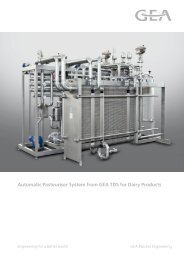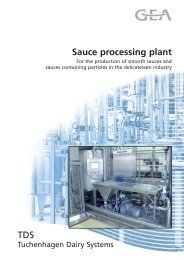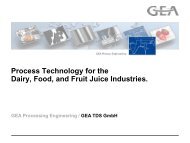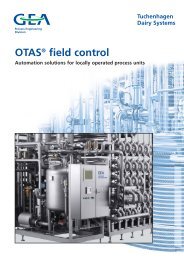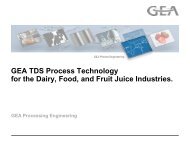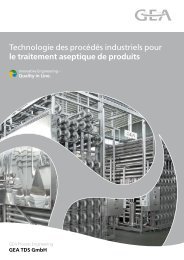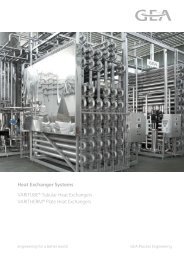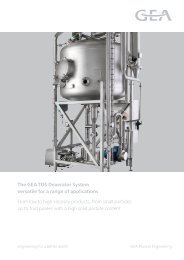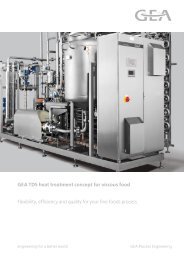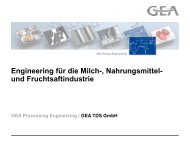Download - Gea-tds.com
Download - Gea-tds.com
Download - Gea-tds.com
You also want an ePaper? Increase the reach of your titles
YUMPU automatically turns print PDFs into web optimized ePapers that Google loves.
GEA TDS Sauce processing plant<br />
For the production of smooth sauces and sauces<br />
containing particles in the delicatessen industry<br />
engineering for a better world<br />
GEA Process Engineering
Tubular heat exchanger<br />
Stirring unit<br />
Plant description<br />
Insulated stainless steel tanks are filled<br />
with a preselected quantity of water via<br />
a recipe management system. When<br />
the specified quantity of water has been<br />
supplied, the basic pasty and powdery<br />
ingredients are introduced into the<br />
circulating water stream by a blending<br />
table, a self-priming centrifugal pump<br />
and a homogenizing pump. In the<br />
homogenizing pump, the <strong>com</strong>ponents<br />
are finely blended in the shear gap<br />
between rotor and stator, thus preventing<br />
agglomeration, lump formation and<br />
cross linking.<br />
The homogeneous blend is circulated<br />
until the entire supply of basic ingredients<br />
on the blending table has been introduced<br />
into the sauce tank. Homogeneity of the<br />
sauce, which at this stage is still cold, is<br />
maintained by agitators.<br />
A positive-displacement pump transfers<br />
the tank contents to a TDS VARITUBE ® M<br />
tubular heat exchanger. The tubular heat<br />
exchanger type M consists of several inner<br />
tubes surrounded by hot water, which<br />
flows in the shell. The tube bundles are<br />
mounted in a “floating” manner so that<br />
the <strong>com</strong>plete bundles can be removed for<br />
inspection purposes.<br />
The modules of the tubular heat exchanger also contain specially<br />
designed flow devices which keep the heat exchanger free from<br />
deposits when processing products containing fibres or particles.<br />
Once the specified heating temperature has been reached and<br />
cold vegetables have been added (optional), the prepared sauce<br />
is automatically kept warm. A push-out program conveys<br />
the prepared sauce to the buffer tanks or the filling system.<br />
Whenever a product change-over takes place, an intermediate<br />
rinsing step with water is performed. After production end, the<br />
sauce tank is subjected to CIP cleaning. Only the blending table<br />
is cleaned manually. CIP cleaning does not require a separate<br />
cleaning system as a cleaning program is integrated into the<br />
control system and the plant already includes all <strong>com</strong>ponents<br />
required for effective cleaning.<br />
Process steps<br />
1. Intake of water and pasty basic ingredients<br />
(tomato puree, mustard, liquid seasoning) and<br />
powdery basic ingredients (starch, spices, binding agents)<br />
2. Blending and homogenization<br />
3. Heating the sauces and addition of pieces of vegetables<br />
(peppers, sweet corn, mushrooms)<br />
4. Buffering the prepared sauces<br />
5. CIP cleaning<br />
Technical data<br />
Capacity in batches 300 – 1,500 l<br />
Time per batch 20 – 30 min<br />
Temperatures 15 – 90 °C<br />
GEA Process Engineering<br />
GEA TDS GmbH<br />
Voss-Straße 11/13 · 31157 Sarstedt · Germany<br />
Phone +49 5066 990-0<br />
GEA TDS GmbH<br />
Am Industriepark 2–10 · 21514 Büchen · Germany<br />
Phone +49 4155 49-2200<br />
GEA TDS GmbH<br />
Kruppstraße 3 · 48683 Ahaus · Germany<br />
Phone +49 2561 8602-0<br />
gea<strong>tds</strong>@gea.<strong>com</strong><br />
www.gea.<strong>com</strong><br />
450e • 03/13 • inform-werbeagentur.de



